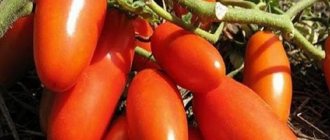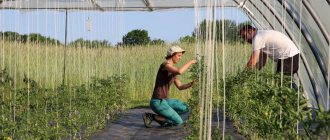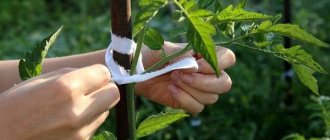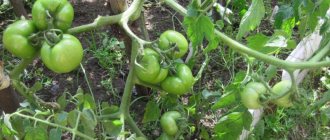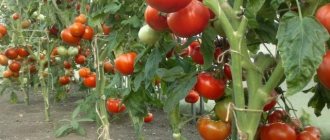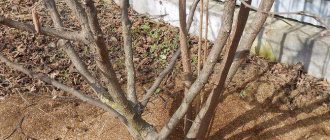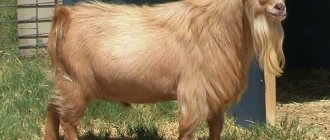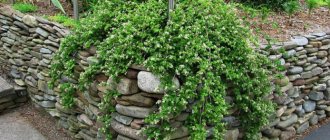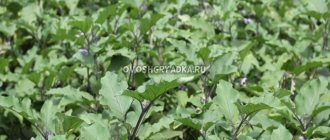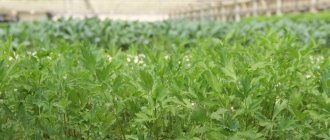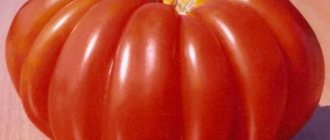When to plant tomatoes
The formation of the first stepsons on tomatoes is observed already at the stage of seedling development. In this regard, when planting seedlings in a greenhouse, they immediately remove all unnecessary shoots, the length of which at this time can reach only about 10 mm. Although this is quite hard work, such bushes will be much easier to care for at first.
After the seedlings planted in the greenhouse take root and begin to grow, they will begin to actively form stepchildren. You will have to systematically (about once every 1–1.5 weeks) inspect the tomatoes and cut off all excess shoots before they become too thick. Removal of stepchildren from greenhouse bushes is carried out regularly even after fruit harvesting begins.
Stepping technology
It is necessary to start pinching tomatoes growing in a greenhouse when the unnecessary shoots are still very thin and small. Make sure that they do not grow longer than 50 mm, because otherwise they will have time to take quite a lot of energy from the bush.
You should also remember that the thicker and longer the stepson, the more difficult it is to tear it off without injuring the stem, and this can cause the bush to be damaged by various diseases. That is why experienced gardeners recommend systematically inspecting plantings and removing stepsons immediately after they appear.
Rules and features of stepsoning:
- The pinching procedure is carried out in the morning, and the greenhouse should be well lit by the sun, and at this time it should be opened for ventilation. It is best to carry out this procedure on a warm, sunny day.
- The stepsons are removed first from the most powerful and healthy bushes, and the weakest tomatoes are left for last.
- It is extremely undesirable to use any tool, even a very sharp one, to remove stepchildren, as this can cause the spread of a viral disease from bush to bush.
- Remove the stepsons by hand. To do this, grab a young unnecessary shoot from above with two fingers and pinch it.
- In the place where the stepson was, there should remain a stump, which reaches a length of about 30 mm. In the future, where there is such a stump, a new shoot will not grow.
- When cutting off the stepson, do not pull it down under any circumstances. In this case, you can greatly harm the bush, stripping part of the stem along with the unnecessary shoot.
Types of pinching
There are several types of pinching, which differ in the amount left during the removal of excess shoots and branches. Each of these types has its own characteristics, which will be discussed in more detail below.
In one stem
The method of forming into one stem is excellent for bushes grown in a greenhouse. In this case, there will be no extra branches thickening the plants, which will provide them with good ventilation and sufficient light.
Immediately after the stepson begins to grow under the first formed brush, it should be cut off. At the same time, the lower leaf plates are also torn off from the bushes, which only hinder them at this stage of development. Next, carry out a systematic inspection of the bushes and cut off all emerging side shoots, while flowering brushes must be left behind.
Thanks to this method of forming a bush, about 50 brushes can grow on it, on which fruits will form. This method also allows you to extend the fruiting period.
In two stems
Forming a bush into two stems is also well suited for greenhouse tomatoes. In this case, you need to leave only one most powerful stepson, which grew under the first flowering brush. Those side shoots, as well as leaf plates that are located below this stepson, must be torn off. In the future, systematically inspect the bushes and cut off all excess shoots.
Three stems
Bushes formed into three stems are most suitable for growing in open ground, but not for a greenhouse. To form a plant into three stems, you need to cut off all the side shoots except two. The first stepson should be under the first flowering brush, and the second one should be above it. Next, the tomatoes are regularly inspected and excess shoots are removed.
How to properly form tomatoes in a greenhouse
All varieties of tomatoes are divided into three types:
- indeterminate - bush growth continues throughout the entire growing season;
- semi-determinant - the bush can stop growing at any time, or it can continue to grow;
- determinant - completion of bush growth occurs after it has formed 4 or 5 flowering brushes.
Indeterminate varieties
If your greenhouse is small, then it is recommended to form tomatoes belonging to indeterminate varieties into one stem. If space allows, then to increase the yield the bushes can be formed into two stems. However, in this case, when planting bushes in a greenhouse, the distance between them should be quite large, which will allow the tomato to receive a sufficient amount of light as it grows.
In order to form a tomato into two stems, you need to leave its stepson, which grew under the first flowering brush. Only 4 or 5 flowering clusters are left on the second stem, and all the rest are removed.
Determinate varieties
In some cases, tomato bushes of determinate varieties do not germinate at all. As a rule, this procedure is resorted to only if they want to get an early harvest. To do this, tomatoes are formed into one stem.
There should be a maximum of four flowering brushes left on it, and all the rest should be cut off along with the side shoots. Above the highest inflorescence, you need to leave several leaf plates and pinch the top growth point of the bush. Thanks to this formation of the bush, the harvest can be obtained half a month earlier.
Semi-determinate varieties
It is impossible to predict whether a bush belonging to a semi-determinate variety will stop growing after it has formed several inflorescences or will continue to grow actively. That is why it is necessary to form a second spare stem on such a tomato. If the main stem stops growing, the fruits will form on the spare stem.
If the growth of the main stem does not complete after 6 to 8 inflorescences form on it, then, if desired, the second stem can be carefully torn off so that it does not take away the strength of the plant.
What is pinching and pinching tomatoes (tomatoes)
Before we talk about pinching and pinching, let's talk about tomato varieties. Among the many varieties of tomatoes, they are divided into the following types:
- indeterminate or tall – no growth restriction
- determinate or bush - with limited growth, in turn divided into: super-determinant (superdeta) - undersized or dwarf
- determinant (children) – with average height
- semi-determinant (half-children) – taller than average
The meaning of the word determinant means that the plant has limited stem growth and the main stem ends its development with a flower raceme. Therefore, indeterminate – having no limitation.
As a rule, low-growing varieties of determinate tomatoes do not require pinching. And then, as a rule, the thought comes to mind - shouldn’t I plant low bushes and not bother with pinching?
Let me tell you right away, some people do just that. But each type has its pros and cons. I want to convey them to you, so that after reading the article once, there will be no more questions left. If you look at the Guinness Book of Records, you can find out that in 1986 a tomato bush 16.3 meters high was grown, on which 12,312 tomatoes grew in 347 days.
This is the main advantage of indeterminate varieties. They are not limited in growth in any way, and if you form a bush into one stem, after 2-3 leaves the bush will produce a flower cluster, then again 2-3 leaves and again a flower cluster, and so on until you stop it yourself. growth, or it will be stopped by the autumn cold.
But they also have disadvantages - such bushes grow normally and bear fruit if they grow into one, or maximum two, stems. As the number of stems increases, the period of fruit ripening increases and they become smaller.
And if you plant such a bush in open ground and give it free rein, it will take over a fairly large area of land. Touching the ground with its stem and leaves, instantly growing into the ground in this place, it will spread throughout the entire area until it is killed by frost.
In contrast, determinate varieties and hybrids of tomatoes have been created for greenhouses and open ground, requiring minimal or no pinching. Their distinctive features are:
- reduced plant height
- earlier ripening of berries and their approximately the same size
- simultaneous ripening of berries
- simple pinching and bush formation
All this can be attributed to their advantages, but there are also disadvantages:
- lower yield due to limited number of flower clusters
- irrational use in high greenhouses
- they require additional feeding
As a compromise, semi-determinate varieties are used in greenhouses. Moreover, they are often confused with indeterminate varieties, because these varieties have mixed properties. And if we take into account that among the indeterminate there are short ones, then confusion is inevitable.
The main thing you need to know is that the main difference is not the height of the plant, but its development during the formation of flower clusters. Indeterminate ones grow and bear fruit throughout the season, while determinate ones tend to stop growing when a certain number of inflorescences are formed.
Thus, the answer to the question of what is pinching and pinching tomatoes (tomatoes) will be the following - this is an event to remove excess, non-fruit-bearing branches that consume nutrients, and aimed at the optimal formation of the bush in order to increase productivity.
Caring for tomatoes in a greenhouse
When growing tomatoes in a greenhouse, special attention should be paid to watering. When the seedlings are just planted in the soil, they should be watered abundantly so that the soil is saturated to a depth of 20 to 25 centimeters. If at this time the young bushes do not receive the required amount of moisture, then they will take root and develop very slowly.
After the surface of the soil near the bushes dries slightly, it should be loosened. This procedure is carried out after each watering, since the crust that forms on the surface of the soil does not allow sufficient oxygen to penetrate to the roots.
The tomatoes are watered the second time only after 7 days have passed after planting them in the greenhouse. During this time, they must have time to take root and adapt to new conditions. The frequency of subsequent waterings is affected by the drying rate of the top layer of soil. On average, tomatoes are watered once every 5 days, with 4 to 5 liters of water taken per 1 square meter of plot.
Also, tomatoes grown in a greenhouse must be fed correctly and in a timely manner. Before planting seedlings in the soil, it should be prepared. To do this, add 1 tbsp. l. potassium sulfate, 2 tbsp. l. superphosphate and 5 liters of coarse sand per 1 square meter of bed. After the ground has been dug up, you can make holes and plant seedlings.
The tomatoes are fed the second time 3 weeks after planting. To do this, you can use mineral fertilizers or organic matter. The next time, feed the plants after a week and a half and use a complex mineral fertilizer for this, for example, Fertility or Ideal.
If desired, tomatoes can be fed a third time 12 days after the second feeding. This time it is recommended to use special preparations that improve the ovary of tomatoes, or you can add the following nutrient mixture to the soil: 1 bucket of water mixed with 1 tbsp. l. superphosphate and with 2 tbsp. l. wood ash. To feed bushes that have begun to actively bear fruit, use nitrophoska and sodium humate.
Feeding tomatoes in a greenhouse to increase the ovary - video
Stepson or fruit brush - how to distinguish
To grow tomatoes in a greenhouse, you need to understand what to pick off on the stems. If a gardener is poorly versed in the structure of a tomato bush, then shoots that bear fruit can be removed instead of shoots.
The extra shoot begins its growth from the axil of a leaf growing from the tomato stem. What begins to develop between the leaf and the trunk of the bush is the stepson. Parasitic shoots are especially active when the first flower clusters appear. Then they get those nutritional elements that are intended for setting tomatoes.
Mistakes gardeners make when planting
Sometimes, when removing shoots from tomato bushes growing in a greenhouse, gardeners make serious mistakes that can cause the plants to become infected with infectious diseases or yield loss. Common mistakes:
- Untimely stepsoning. Excess side shoots must be removed systematically and in a timely manner. If you carry out such a procedure once a month or even less often, then it will be of little use. The fact is that long and thick stepsons will already have time to take away a significant part of the bush’s strength.
- Pruning not the stepsons, but the fruit branches. Often, inexperienced gardeners confuse these shoots. Carefully inspect the location where the shoot grows. If it does not grow from the leaf axil, but directly from the stem, then it is a fruiting branch and does not need to be cut off.
- Dirty tools. Experienced gardeners recommend removing stepchildren by hand. But if you use scissors for this, then be sure to disinfect them after trimming each bush. To do this, it is recommended to wipe them with any disinfectant solution, for example, a solution of potassium manganese. If this is not done, then from one diseased bush the infection can be spread to all bushes. If you tear off unnecessary shoots with your fingers, then make sure that tomato juice does not get on them, since it can also spread the infection.
- Applying too much fertilizer. If the bush has already been formed, but stepsons are still actively growing in its lower part, this means that too much fertilizer is being added to the soil. In order to correct the situation, stop feeding for a while or adjust their regimen and dosage.
Tomato varieties that do not require pinching
All varieties of tomatoes are divided into three varieties, for each of which they choose their own pinching scheme:
- Tall. These plantings are the most fruitful. They give a harvest for 2 months. Due to the height of the plant, it requires staking to stakes. The main problem is the rapid and abundant appearance of stepchildren. Therefore, bushes need systematic pinching. If, after removing the shoots, “stumps” are left in their place, this will slow down the growth of new stepsons. On a large plant there are 10 fruiting vines - the rest are pinched. The plant is formed into 1-2 stems, leaving up to 4-5 flowering clusters on each. After the first fruits appear, the lower leaves must be removed. Their presence impedes air circulation, prevents fruit ripening, and contributes to the appearance of rot.
- Medium height. It is preferable to grow these varieties in 2-3 shoots. The main problem of the variety is topping. After pinching the stepsons, the bush may stop growing. In such a case, you can leave 2-3 shoots. If the plant stops developing in height, additional shoots can be formed on them.
- Short. Such plantings do not require pinching, as they do not produce such shoots. After 4-5 side stems appear, pinch the plant - this stops the appearance of new branches.
For new gardeners, I recommend tomato varieties that do not require pinching: Agata, Parsley-gardener, Beta, Sanka, Windrose, Oak, Fat Jack, Gnome, Lagidny, Armenian early, Gavrosh, Siberian early ripening, Yamal, Alaska, White filling 241, Boni M, Ground Gribovsky 1180, Raketa, Moskvich, Vershok.
